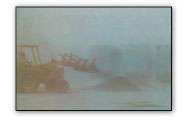A Retrospective 1980 – 1989
The eighth in a series of quick peeks into the world of commercial vehicles through the lens of Commercial Carrier Journal
Ushering in a new era
“The industry survives.” That was the declaration of the American Trucking Associations upon President Carter’s signing of the Motor Carrier Act of 1980. “To hell in a hand cart,” another analyst foretold of the regulation’s effect on the trucking industry. Indeed, the landmark legislation turned the industry on its ear, phasing out collective ratemaking and knocking down barriers to entry.
Not only did the trucking industry survive the years that followed, it prospered. Deregulation ushered in a new era of price competition, forcing carriers to become more efficient and innovative. Companies with competent management were rewarded, while inefficient operations were forced to adapt or go out of business.
“The emphasis as we move into a post-industrial state,” said a company vice president for Ryder Truck Lines and Pacific Intermountain Express in an address to the California Trucking Association, “is going to be more and more on time-sensitive, high-value commodities, and it is their service requirements which will dictate the upcoming changes in the freight system.”
In 1986, Congress passed legislation – the “Anti-Drug Abuse Act of 1986” – that contained a rider that established minimum national licensing standards states would have to follow when issuing commercial drivers’ licenses and made it illegal for interstate truck drivers to hold multiple licenses. At the time, 19 states allowed anyone with an automobile drivers’ license to operate commercial vehicles. The legislation also mandated operating front wheel brakes.

After the energy crisis in the previous decade, the 1980s saw a host of equipment innovations aimed at cutting fuel consumption and improving fuel economy. Continuing refinements to the diesel engine – including electronic control of unit injectors, an overhead camshaft, header-type manifolds and turbocompounding – all incrementally helped boost fuel economy. Low-profile and super-single tires appeared on the scene. On the OEM side, the first aerodynamic tractor designs emerged, including the Kenworth T600 (pictured) and the Peterbilt 379.
Blowing her top

Fleets with an estimated 350,000 trucks operating in the Northwest faced immediate maintenance concerns due to fallout from fine volcanic ash particles in the atmosphere, as did industry suppliers and OEMs in the area, including Freightliner. The manager of the Spokane division of the Safeway Stores grocery chain said of its truck operations, “we took out as much as two shovels of ash out of dry air cleaners during each round trip between Spokane and Seattle.” Daily servicing of wet and dry air filters, 5,000-mile oil change intervals and daily lubings became the norm as carriers like Consolidated Freightways, Pacific Intermountain Express and others in the region battled the abrasive contaminants. n
Visit www.CCJ100.com for an in-depth timeline detailing news and events in the trucking industry from this decade and share your company’s history.












